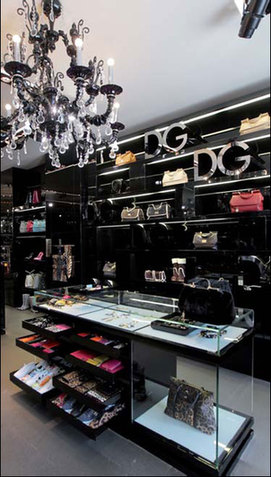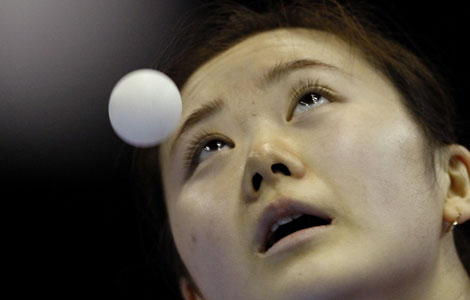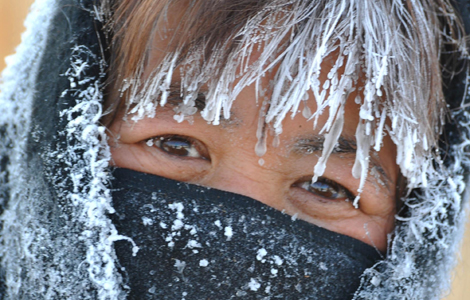Top-class invasion has best brands lining up
Updated: 2011-12-02 10:51
By Xu Junqian (China Daily European Weekly)
|
|||||||||
Shanghai offers a showcase that glitters
The morning glory has just broken through the dense mist above the Huangpu, casting a golden glow on the rows of exotic buildings along the river, the city landmark everyone knows as the Bund.
While the city sleeps off the revelry of the previous night - and in all likelihood the previous nights, too - the day begins for two big shots in the fashion industry at their brightly lit store in the Bund 6.
"We come here to meet people and understand what they are thinking," says Stefano Gabbana, as his partner in business, and once in life, Domenico Dolce, takes a look over their flagship China store on a chilly November morning just after the big clock on the Bund has struck nine.
It is not the first time that the two founders of the Italian fashion house Dolce&Gabbana have visited Shanghai, and they reckon it will not be the last, promising to come back every six months.
 |
|
A number of luxury brands such as D&G have set up stores along the Bund. Gao Erqiang / China Daily |
"It's just like New York, London, and Milan decades ago. And it's growing so quickly," says Gabbana, who regards Shanghai (and for that you can probably read China) as the next most important market in the world, if it is not already.
And they are trying to conquer the "next most important market" right from here, in the 900-square-meter store on the Bund that opened 13 months ago.
The store, featuring walls made of black crystal and mirrors, a spiral staircase and floors made of volcanic rock, has become one of the most popular shopping drawcards in town, and not just for fashionistas and party-goers with too much money too spend.
"We want to learn what people here are thinking, why they are choosing this over that and, essentially, the Chinese culture," says Gabbana, in an English garbled in an Italian accent as thick as some of the winter wear hanging on the racks.
However, it seems that Dolce and Gabbana are not the only ones eying the Chinese market and using as a staging post the Bund, the must-go tourist attraction in Shanghai that draws millions of travelers a year, and the most high-end venue for well-off locals to shop, dine and wine.
In fact, a number of luxury brands including Cartier and PRADA have set up stores along the Bund, like armies setting up their command posts in the most strategic locations, transforming what was once the Wall Street of the Orient into les Champs-Elyses de l'Orient.
The idea of bringing luxury into the century-old Bund was introduced seven years ago by Li Jinghan, a US-born Chinese. The former associate partner of a US law firm spent four years turning a seven-story neo-classic style obsolete bank building into a monument to luxury that boasts water buffalo leather chairs, antique glass from Belgium, and the flagship store of the Italian fashion house Emporio Armani, the first one in China. He named it Three on the Bund.
"When I first came to Shanghai in 1999, I found, surprisingly, that the city did not have such a place that blends history, luxury and culture for shoppers, despite its international repute as a shopping paradise," Li told a local magazine then.
"I want Shanghai to have something that other metropolises like Paris, New York and London all have, something other than the uniform department store."
As a result, the refurbished building proved to be a great success, attracting shoppers from all points of the compass, near and far, and has served as a perfect business model for restoring other run-down buildings along the embankment to their former glory.
Figures on how many world-class luxury brands are housed in the 52 buildings along the 1.5-kilometer embankment, also known as Zhongshandongyi Road, are not easy to come by.
Sales figures, too, are hard to come by, because each outlet operates independently and in fierce competition with one another. What is known is that names such as the men's wear label Zegna and the watchmaker Patek Philippe keep on flocking to the Bund.
At the end of 2009, for example, with the opening of Shanghai Peninsula Hotel, a galaxy of the world's top brands was introduced into the 6,500-square-meter store on the ground floor of the hotel, including the flagship store of the French fashion house Chanel.
At the northern end of the Bund, said to be the genesis of the area, an even bigger and more ambitious project, RockBund, is taking shape and the first stage will open before the end of 2014.
The project, covering a total area of 18,000 square meters of land and described as "an urban renaissance" by the developer, will be a complex of high-end restaurants, office buildings and luxury stores.
"The Bund has always been an important name card of the city," says Yang Yongshi, general manager of Aspire, a real estate agency.
"But for the past decades it always remained a question as how and who could use the name card properly. Now, those traditional luxury brands from Europe seem to be in perfect harmony with the history and culture of the Bund."











